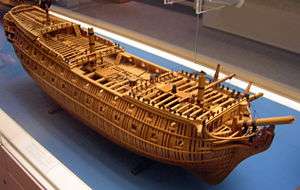HMS Egmont (1768)
 A model of Egmont, held in the National Maritime Museum. | |
| History | |
|---|---|
| Name: | HMS Egmont |
| Ordered: | 6 June 1765 |
| Builder: | Deptford Dockyard |
| Laid down: | October 1766 |
| Launched: | 29 August 1768 |
| Fate: | Broken up, Chatham, Kent, 1799 |
| Notes: |
|
| General characteristics [1] | |
| Class and type: | 74-gun third rate ship of the line |
| Tons burthen: | 1642 76⁄94 (bm) |
| Length: | 168 ft 6 in (51.36 m) (gundeck) |
| Beam: | 46 ft 11 1⁄2 in (14.3 m) |
| Depth of hold: | 19 ft 9 in (6.02 m) |
| Propulsion: | Sails |
| Sail plan: | Full rigged ship |
| Armament: |
|
HMS Egmont was a 74-gun third rate ship of the line of the Royal Navy, launched on 29 August 1768 at Deptford. She was designed by Sir Thomas Slade, and was the only ship built to her draught.[1]
Egmont was part of the squadron commanded by Admiral John Gell which escorted a Spanish ship they had captured from the French back to Portsmouth. The ownership of the Spanish ship was a matter of some debate and was not settled until 4 February 1795 when the value of the cargo was put at £935,000. At this time all the crew, captains, officers and admirals could expect a share of the prize money—Admiral Hood's share was £50,000. Besides Egmont, the ships that escorted her into Portsmouth were HMS St George, HMS Edgar, HMS Ganges and HMS Phaeton.[2]
Egmont suffered heavy damage in the Battle of Ushant in 1778. Her captain reported to Admiralty that the vessel received eleven cannonballs to the starboard side and two more through the mainmast. The mizzen mast had been shot through and fallen overboard and the foremast had shattered in its centre section.[3]
Egmont participated in the Battle of Cape St Vincent (1797) under the command of Captain James Sutton.[4] She was broken up in 1799.[1]
Citations and notes
References
- Lavery, Brian (2003) The Ship of the Line - Volume 1: The development of the battlefleet 1650-1850. Conway Maritime Press. ISBN 0-85177-252-8.
- Willis, Sam (2008). Fighting at Sea in the Eighteenth Century: The Art of Sailing Warfare. Boydell Press. ISBN 9781843833673.